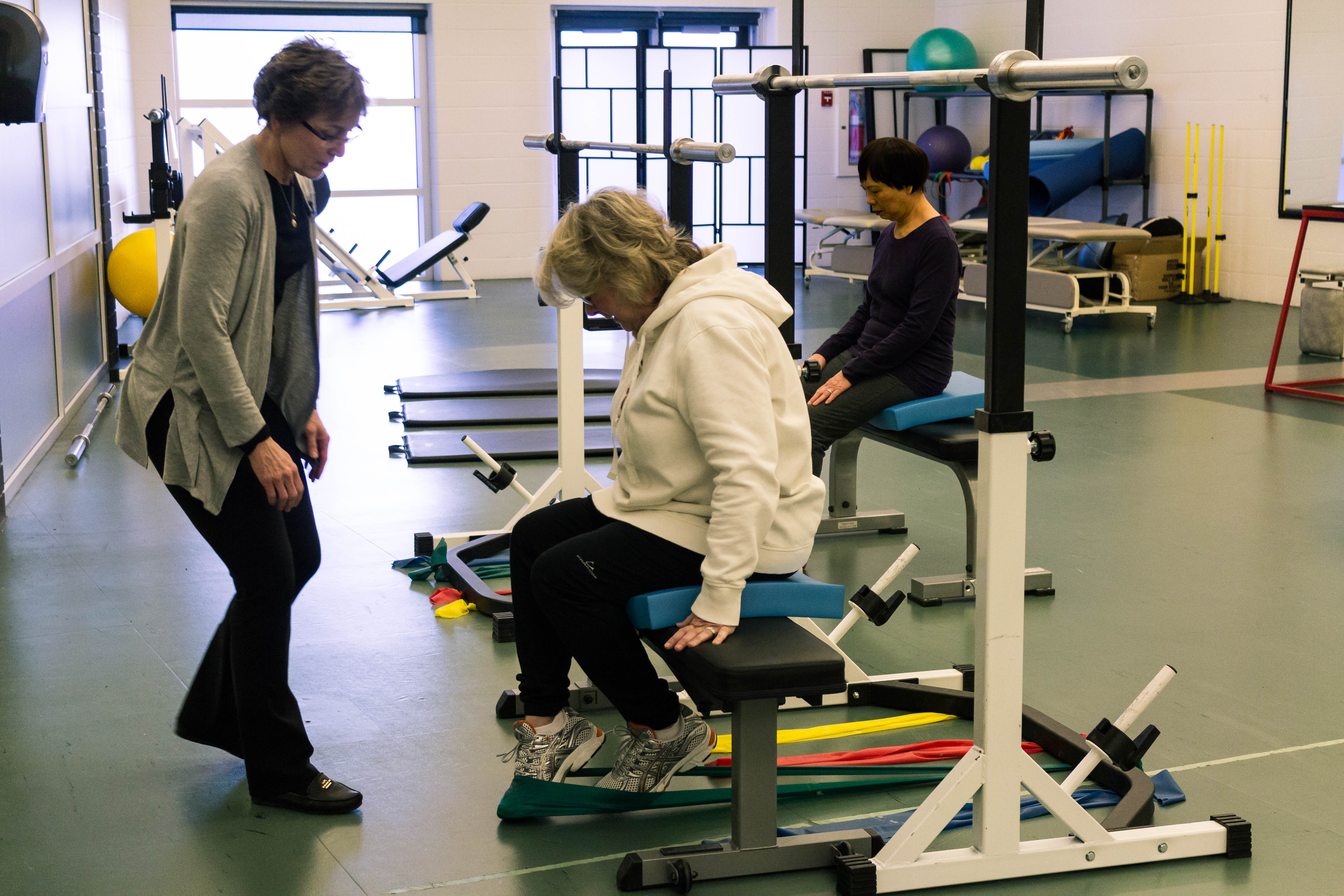
Glen Sather Sports Medicine Clinic GLA:D™ Canada program participant Patricia Johnston practices her specialized exercises during a session with physiotherapist Rhonda Highland.
Patricia Johnston is an active person. She's someone who enjoys outdoor cycling, rollerblading, ice skating and walking, to name a few. Any type of outdoor activity she can participate in, she will.
But there's one problem: Johnston has osteoarthritis-a disease the results in joint degeneration and is one of the fastest growing health conditions globally.
Now, Johnston has trouble just walking up and down stairs-walking, period. And she most definitely cannot enjoy all of the activities that used to be a main staple in her life.
That is, until she was introduced to the University of Alberta's Glen Sather Sports Medicine Clinic's GLA:D™ Canada program.
"Osteoarthritis affects everything I do. I can't sit or stand for too long, I have trouble walking up and down stairs and I can't walk uneven surfaces," says Johnston. "It's very limiting."
The GLA:D™ Canada program was adapted from the Good Life with osteoArthritis: Denmark (GLA:D®) program. Working with the researchers from Denmark, The Canadian Orthopaedic Foundation received the license for the program under the name GLA:D™ Canada. The Glen Sather Sports Medicine Clinic's new GLA:D™ program-one of the first to launch in Alberta-officially began in October 2016. Its goal is to help individuals affected by hip and knee osteoarthritis regain their mobility by providing them with education and specialized exercise routines to strengthen their muscles and reduce pain, and has already been shown to reduce the progression of symptoms associated with osteoarthritis by 32 per cent.
"In 2010, it was estimated that over 4.4 million Canadians were affected by osteoarthritis," says Jackie Whittaker, director of research at the Glen Sather Sports Medicine Clinic and assistant professor at UAlberta's Faculty of Rehabilitation Medicine. "And this number is expected to double by 2040.
This is why the GLA:D™ Canada program is needed-so we can keep all Edmontonians and Albertans, regardless of their age or current condition, active and healthy."
Although there are many causes of osteoarthritis, the two most established risk factors are previous joint injury and obesity, adds Whittaker. And while there is no cure for osteoarthritis, there is substantial evidence that exercise therapy combined with proper education and weight management can reduce pain and improve function.
Johnston, who was one of the first people to enroll in the program, has already seen major improvement in her everyday movements.
"Just from doing the exercises and getting the correct information, and learning how to walk and stand differently, the muscles around my hip joints have strengthened," says Johnston. "In the first session [of the program], I was only able to do four chair sit/stands in 30 seconds. Now I'm doing up to 15 in about a minute."
And that's all on her own. Before the program, Johnston would need assistance or something to hold on to in order to stand up from a seated position and vice versa. Even putting on socks or shoes was a difficult task.
"I can definitely see my mobility improving. I have less pain, but it doesn't mean that it's completely gone. I still have to be cautious to a point, but I'm very impressed with the program and the results so far. It gives me hope."
Since achieving a reduction in her hip pain, Johnston has been able to forego hip replacement surgery, which can be a stressful procedure with weeks of down time. Instead, she is spending her time making goals to get back to some of her hobbies by the spring-her regular 16 km cycling route and maybe even some rollerblading.
"My strength and mobility are increasing every week thanks to the exercises that I'm able to do at home. I'm confident I'll be able to build up my strength enough to reach my spring goal.
It'll be nice to get back to cycling and being outdoors. But one of the greatest things that the program has helped me with is being able to play with my grandchildren, which usually requires being able to get down on and up off the floor," she laughs.
For other individuals with hip and knee osteoarthritis who are interested in taking the program, Johnston says the key to success is an open mind.
"Even if you feel pain, even if progress seems like it's slow, you can't quit. Do as much as you can and push yourself. You will be surprised what you can do.
The results are worth it. An hour twice a week-that's completely doable for anyone."
The Glen Sather Sports Medicine Clinic GLA:D™ Canada program is currently accepting patients for four sessions that will be running from January to September 2017. For more information about session dates and how to participate, visit the Glen Sather Sports Medicine Clinic website. For more information about the GLA:D™ Canada program, visit gladcanada.ca.